"Zodiac: A big wall climbing story"
Sept 1994 Zodiac: Climbing El Capitan Yosemite
Climb by Brad Carlile & Brian Baker
Story by Brad Carlile
Through an ocean of darkness, to quick luminous rivers accentuated by bright pops of light, ... our eyes have trouble focusing, colors blur... rattling noises, ringing noises... we move forward. We are startled and overwhelmed by everything that fills the air around us. All is unexpected and dynamic ... our gait is jerked about as our senses are piqued by a succession of sudden impulses. The mind cannot keep up with this sensory overload, since all seems unique - we filter nothing out. This is a visually-absurd and complicated place, thankfully our task is simple - we are in search of a large slab of prime rib. We are in a likely place for this meal, however a Reno casino is a weird place. We had been in a variety of alien locales lately.
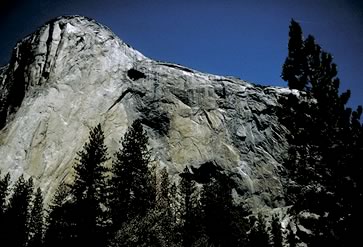
The day started when we awoke on top of El Capitan in Yosemite California. We had finished climbing the classic big-wall route "Zodiac" - another surreal place that is far removed from anything prosaic. On the vertical face of this huge cliff, we lived for days. Indeed, this monumental surface defined our entire universe. We existed inches away from square miles of sheer rock surface that extended away from us in every direction
To help us climb in this barren realm, we scoured the surface for any bit of information. Somehow we moved upward. We had to focus on one day at a time, otherwise, we would get lost in the enormity and the task would seem too daunting. We were insignificant in this vast frozen sea of granite.
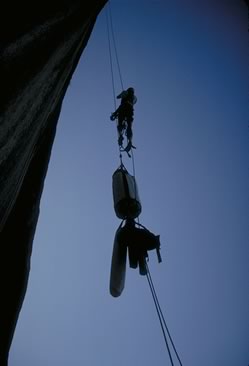
At the base of this route, El Cap looks very much like any other vertical or overhanging cliff - very intimidating. However, it is only after being dwarfed by this immense expanse for two, three, or four days that the scale of El Cap truly appreciated. Zodiac is challenging. It is a rock-flake hooking, iron-piton nailing, brass-RP wedging, steel-rivet hanging, aluminum-Alien camming, sort of aid climb. Even the nights are a bit more extreme; we sleep on portaledges
At times this journey has an intensely physical orientation. But, the mind is on a journey that rivals the body's journey. Both journeys are rooted in physical events, however the mental path taken is more complicated and circuitous. The mind is challenged by the hard climbing - but freed to reflect on life and to be inspired by the surreal beauty. A positive outlook is the glue that holds everything together, otherwise the mind rots and some excuse will be made quit the climb and return to the ground.
Before the climb, the mind-expanding aspects of the journey seemed less important; I focused on the climb in an intellectual and physical manner. Articles were read and the Internet was surfed for route information. There was a wide variation in gear lists, so we made our best guess. Big-wall climbing is gear intensive and attention to detail is helpful. To prepare, we trained on short routes and acquired the needed gear. It all seemed manageable and orderly, after all a year before I had been on an easier big wall.
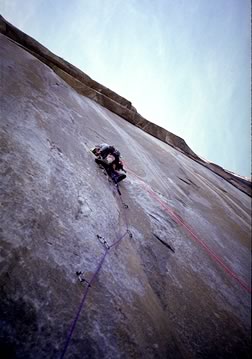
I pondered the difficulty of Zodiac's rating of 5.11 A3. A3 is the rating at which some of the gear used to climb will only support body weight. Scary. Mentally, there is no crux to prepare for since many pitches are rated A3. The positive side of this consistency is that it prevented me from ever dreading any particular pitch.
Analytically, I knew how hard it was and that it could get a lot harder. The limit of aid climbing is A5. On these insanely difficult routes, big-wall connoisseurs climb on steep loose rock with the potential of deadly full-length rope falls. Amazing.
When Brian, my coconspirator, and I arrived in Yosemite, our first task was to gain a sense of water consumption on the wall and garner any new route information. The temperature in the valley had hit record high levels during the previous weeks. Unfortunately, little information was gained by strolling through the climbers campground and chatting to anyone with big-wall gear. Most were either preparing for or had bailed off of easier routes. We headed to the base of the climb to scope out the route.
At the base we ran into two climbers who finished the route on the previous day. One of their comments was "it's very steep up there." They were very helpful in sharing gear recommendations. This added to our confidence since we had adequately planned our gear. We spoke more about the climb as we hiked up to the base. Before we parted company they said "keep your confidence, ...you can do it, just keep your head, did we mention that it's steep?" As we found out, they were quite right. Most of the route is 10 degrees past vertical. This climb is continuously in one's face. I would often quip to Brian, "There will be enough suffering." We wanted a challenge and we were not going to be disappointed.
We returned to camp to pack the haulbag or "pig". As we surveyed all of the gear being packed we continually asked each other, "...do we really need all this shit?" Only gear that is essential for the climb is taken; most without backup. Nevertheless, the amount required is staggering.
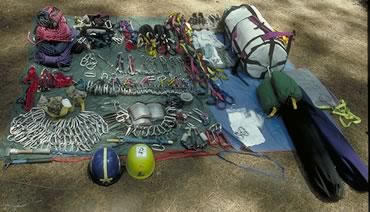
We had to keep track of over 300 items. The total equipment weight at the bottom of the route was over 230 pounds. Food, water, and clothing were all packed into the pig; it weighed in at 147 pounds. All climbing hardware was carried on our shoulder and waist harnesses. Tucked away in this mass was a good stock of one of the keys to big wall climbing - bubble gum - it's hard to explain, suffice it to say that it came in a dream.
The plan was to fix a couple of pitches and start the next day. For me, the first pitch set the tone for everything that was to follow. Never before had I felt so good on a hard climb. I was in a well-balanced state of mind: confident - yet not cocky, fast - yet not reckless, and scared - yet not overcautious. Movement was calm and focused. Wow. A positive attitude would get me through a lot. The taste of adrenaline was like a good spice, it added to the main course but did not overpower it (earthy and robust - like a good thyme chicken). The months of training for this climb were to hold us in good stead. The first pitch went with mainly free gear except for my first-ever pin stack of a lost arrow and a leeper Z. On pitch 3 another new aid experience was moving from a nearly hidden bat hook placement to a bolt stud with only one thread left. A doubloon was duct taped onto this stud. I relished in the details. This was not a normal climb. I was joyfully in new territory.
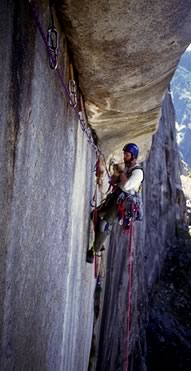
After leaving the ground, the typical 3D landscape turns into a crazy wide-open, two-dimensional "wallscape" that is tipped on its end. At this point an El-Cap-centric point of view is acquired. Even the dangers seem simple and apparent, especially when compared to the hidden dangers of the presumed safe and civilized world. The wall becomes the frame of reference and the measure of all things. Life is simple here. Time is measured in terms of wall progress. Distance is measured in ease of wall movement. The cliff face defines everything that is solid and important. Everything else - the ground and the sky - are so removed and unreachable that they take on the appearance of a magnificent visually absurd wallpaper.
The best-laid plans clearly do not have much to do with wall climbing. The day after fixing the pitches, we started late due to waiting for the party in front of us. Their promised "alpine start" turned into an "approaching mid-morning start". Finally, we were off. The climbing was interesting, but the hauling -as always- was a chore. My twenty-pound weight advantage over the pig was not enough. In order to haul, I placed both hands and feet above my butt and pushed downward - the pig inched upwards. After lowering myself in this fashion for several feet, I raised myself up and repeated the process.
We climbed. We hauled. The day was not as productive as we had hoped. My unwittingly dividing pitch 3 in half, the ropes getting tangled, and the difficulties of Brian doing free climbing with a 50-pounds of aid gear all wasted time. In the void of the night, we struggled to set up our portaledges for the first bivy.
During the night we slept with our harnesses on - an important wall rule. Portaledges really can be quite comfortable after a strenuous day on the wall. Only the full moon prevented us from a completely restful night. The moonlight had the feel of a flashlight continuously being shined in our eyes.
In the morning we had to deal with a rather difficult pig. Evidently, it did not like being unpacked at night, nor did it particularly care to be packed while dangling from its straps in the dawn light. Maybe our organization left a bit to be desired. We were off to another late start. My climbing started with back cleaning an exhilarating arching rivet ladder on pitch 5. Cool. Our late start coupled with our lower-than-desired position on the wall prompted Brian to petition for a return to the ground when I finished leading pitch 5. For me the climbing felt so good, I wanted to continue. But we were not where we should have been. He was right - so we bailed. It took all day to lower off the wall and return to the valley. Bailing hurts in many ways, but it is often the smart thing to do.
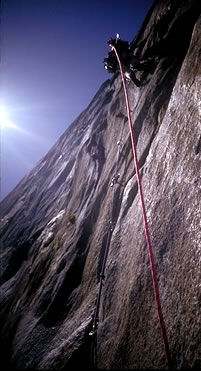
This climb was meant to be Brian's reemergence into the climbing world. After several years of not climbing much, it would have been a nice triumph for him. But now here we were, in the valley after bailing. We were both disappointed. The wall was the focus of my trip. My mind drifted; my purpose in Yosemite had been removed. I was rather listless. I rested and wandered the valley for several days. Brian did some climbing. One day with renewed conviction, we started packing for another attempt. I was re-invigorated by the possibility of getting back on the wall.
We started the wall confident of success the second time. I was determined to demonstrate my experise to myself by climbing pitch 1 and pitch 3 faster this time around. My over-exuberance was to be met by the only two lead falls on the trip. The steep nature of the wall allowed both falls to be clear of the wall. I'd like to blame the first fall on a modification I made to a tricam (filed to fit pin scars), which I had learned about second hand from someone at the valley climbing store. Later, I was told it takes several tries to make this modification work well. So much for" trying it on the wall". In reality not focusing on simply climbing well was to blame for the falls.
After the first bivy, I awoke to views that had a misty Monet-like rendition. I blinked madly until my dry contacts moistened and the view came into focus. After eating some canned fruit and peanut butter, we repacked the pig. Things seemed to work better this time. We climbed well and made reasonable progress during the day. Our trimming on water to save weight would mean that the slight taste of dehydration would accompany us to the top.
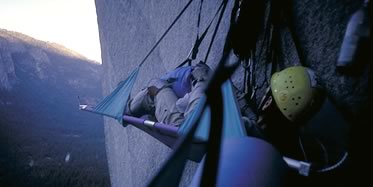

The free hanging rope used to haul the pig acted as carpenter's "plumb" that told us the exact direction of the ground. We were on the overhanging section that was to continue to the top. It was steep. When preparing to haul, the pig is released from the anchor. Newly freed it would gracefully arc into space and swing back and forth like a giant pendulum. I was always a bit uneasy at this point. It would be a shame if something went wrong and the pig plummeted to the ground.
Often the connectivity of people and things in our lives goes unnoticed. On the wall, these bonds are embodied in the physical connections of the rope, biners, and slings. Everything is somehow tied together. Dropping things is not an option. In the pedestrian world we often take this connectivity for granted; you can toss something aside and pick it up later. On the wall, anything dropped only has a chance of being found after the climb where it will show the severe effects of slamming into the ground after reaching terminal velocity.
Aid climbing is slow work. A single rope length took anywhere from an hour and a half to three hours. During these long climbs, different songs would come to mind and resonate with my thoughts. The lyrics recalled by my subconscious offered entertainment, feelings about things removed from the wall, climbing advice, or farce. Sometimes they complimented a particular task at hand. For example, when moving up on a tenuous piece of gear I'd sing words from a "Counting Crows" song:" ...I'm not gonna bend, I'm not gonna break, not going to worry about it any more..."
With each gear placement, one has to discern the shape and complexity of each crack and match it with the available gear and a multitude of possible orientations. Creativity is important for a successful placement. An aid climb is an evolving puzzle that must be solved with every step upward. A sample sequence may be: an old cracked fixed piton, to a small RP, to a bat hook, to an old copperhead "bashie"; or a friend with only a couple of cams firmly placed, to a series of tied off pitons, to a tricam in a flaring crack, to a knifeblade piton driven straight up into a crack. This slow and deliberate work affords the leader the opportunity to over-scrutinize and over-examine the precarious nature of each piece during the ascent.
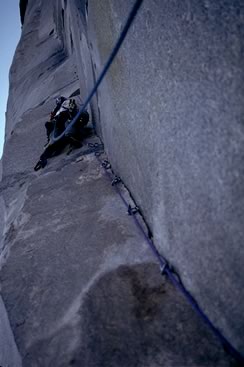
Brian's favorite pitch was number 9. It was a very long, continuous 110 degree dihedral that required a blind placement around an edge into another crack. While Brian was focusing on this difficult climb, my mind wandered. The excitement of the climb contrasts with the boredom of the belay.
The belay is time for reflective thought, wandering thought, or silly thoughts to pass the time. When in a contemplative mood, I thought about the important things in life - family, friends, and love. I wondered if the next woman I got involved with would be the one. Here I was, a romantic dreaming of love, suspended a thousand feet above the ground wearing the same smelly clothes for days. Life can be quite strange. As time passed, my mood would change and I would become a simple observer of my surroundings. Suddenly, I witnessed hundreds of silverfish (one every square foot) moving up and to the left for some unknown reason. But what really caught my eye was one silverfish moving down and to the right... I must search for the meaning in this some time.
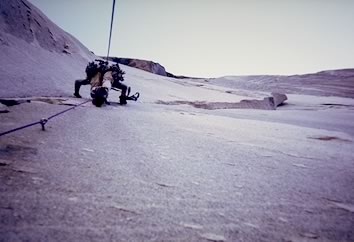
In the early morning light, I started by climbing the section called nipple pitch. This enjoyable, long traversing pitch required quite a few pitons. Due to my inexperience with pitons, throughout the trip I seemed to place them with a certain overdriving zeal. When Brian was trying to remove the pitons, I thought I heard him swear at me in several languages - some of which he did not know. His next pitch was "The Mark of Zorro". This fractured section of rock and series of A3 roofs would be a Cubist painter's dream. Climbing it required wild acrobatics and a stomach of steel. Brian ended the pitch with a very sporting and very dicey placement of a loose lost-arrow piton equalized with a loose copperhead" bashie". As night fell, the top was within our grasp.
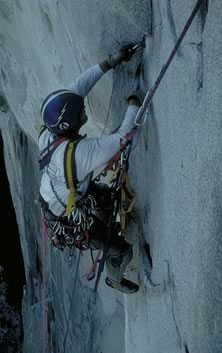
As we toiled, the rest of the El Cap universe continued indifferent to us. Swallows were our constant companions on the wall. While belaying we would watch them endlessly darting about and chasing each other in quick high-banked high-thrill rollercoaster turns. Often they would get quite close to us. Peregrine falcons also nest on the wall. Many climbs on the wall near Zodiac are closed to climbers during the nesting months. At first I didn't see them, but I could hear their constant squawking and screeching with, as I perceived, whining undertones. They irritated me during some of the long hours on the wall. My perceptions of them underwent a complete revision when I saw these masters of the sky first come into view. Falcons are very adept in the windy turbulence of the half world between El Cap and the valley.
One of the highlights of the last day was climbing a large crack that was formed between a potato-chip thin flake and the body of El Cap. This crack was climbed by using a #4 friend walk for almost an entire rope length. It was protected with an occasional rivet or bolt. A cool, clean breeze with the odor of a freshly plowed field emanated from the crack. We would soon leave the surreal and stand on terra firma.
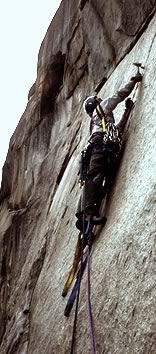
Brian's last pitch was a couple of thrilling hook traverses that were joined by several vertical cracks. On the second hook traverse, I looked directly above in time to see Brian accidentally prying a oven-door sized flake away from the wall and pivoting it toward me! This surprised both of us. Astonished, Brian quickly re-seated the potentially decapitating flake. After a few deep breaths, the climbing continued.
As I started the last pitch, which was easier than the previous climbs, I was slowed by a strong urge not to mess up this close to the top, and the desire not to have the climb end. The first view as my head came over the edge was of Half Dome awash in the alpine-glow of the setting sun. Glorious. I reflected on fond memories of last year's big wall climb on Half Dome. Brian topped out shortly after I finished hauling the gear to the top. The ascent of the route was complete.
As we reentered the three-dimensional world, the horizontal landscape was unfamiliar. Things surrounded us. Nothing had to be tied-in. We could throw gear, untied, to the ground and it would stay. Weird. Ropes, gear, and clothes were strewn and splattered about in a manner that made the bivy site look like a post-modern Jackson Pollack climbing store. Walking on two legs was itself strangely odd, our feet comically plopped in marionette fashion. We had many adjustments to get back to our pre-climb ways.
That night, I reflected on the climb. The enormous amount of energy required for a big wall dwarfs the enjoyment, but somehow big wall climbing is rewarding and life affirming. Life is straightforward but tough there - this brings a certain clarity to the mind. It seems easier to gain insights into life when you step back a bit and remove yourself from everyday concerns. The mental journey on the wall is very interesting in this visually absurd world. There will be more big walls in my future. Big wall climbing is one of life's experiences that I want to get a good drink of during my time. It certainly tends to keep one out of the ruts of habit and the potholes of normalcy.

In the morning light, we ate breakfast, divided up the 160 pounds of remaining gear and headed for the valley floor. High on the descent, several Peregrine Falcons let out long screeches. As we looked up, one of the Falcons, not more than 30 feet away, was carrying a bird bigger than itself for a falcon breakfast. It was an amazing view.
TThe hike down was not on the best imagined path for this load; there were three full-rope rappels. Evidently "The Captain" wanted to whip us a bit more before letting us return to the valley. As we left, we stopped at El Cap meadows for one last look at "the big stone". This last glance complete, we headed to Oregon. That night we stopped in Reno; we were in search of a large prime rib dinner.
{link to 1994 climb beta and other technical information}
Brian: Thanks for a Great Climb!
El Capitan, the Captain, "The Stone", and El Cap are just a few of the things we call that wonderful place.